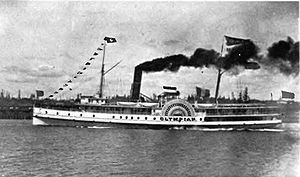Name Olympian In service 1883 | Completed 1883 Out of service 1890 | |
 | ||
Owner Oregon Railway and Navigation Company Route | ||
The steamship Olympian operated from 1884 to about 1890 on the Columbia River, Puget Sound, and the Inside Passage of British Columbia and Alaska. Olympian and her near-sistership Alaskan were known as “Henry Villard’s White Elephants.” Olympian the large iron sidewheeler should not be confused with Olympian (ex Telegraph) a wooden sternwheeler, which also served on Puget Sound and was one of the last commercial freight steamboats operating on the Columbia River.
Contents
Construction
Olympian was built in 1883, at Wilmington, Delaware by Harlan and Hollingsworth. She was a sidewheeler driven by a single cylinder vertical condensing walking-beam steam engine, which gave her high speed. Her iron hull was 262 feet (80 m) long, 73' in beam over the paddle guards, and rated at 1419 tons. She was built primarily for service on Puget Sound, as her draft of 8' feet meant she needed too much water to be of much use on most of the Columbia other than the lower river from Portland to Astoria. Mills described her as follows:
Operations in Pacific Northwest
In 1884, Olympian was brought to the Pacific Northwest through the Straits of Magellan, all the way around South America; the Panama Canal would not be built for another 30 years. Olympian was built according to designs which had been popular and successful on Chesapeake Bay. When she arrived in the Pacific Northwest, these designs proved unsuited for the conditions, and the ship became a steady money-loser.
Puget Sound service
On arrival in 1884, Olympian was placed in service by the Oregon Railway and Navigation Company (then controlled by Henry Villard) on the Seattle-Victoria run that had previously been served by North Pacific. Olympian served on this route until 1886 when she was transferred to the Columbia River. There is a story that on one of the runs from Victoria to Port Townsend, five Chinese men seeking to enter the United States (apparently at a time when entry of Chinese nationals was barred by the Chinese Exclusion Act) hid within the paddle guards. Fortunately they survived (only to be deported back to Canada) although they were nearly drowned by the amount of water picked up by the paddle buckets.
Columbia River service
Olympian ran for a while on the Columbia River mostly on the Columbia to Astoria run. Mostly she was unsuccessful, being too expensive and not much faster than her rivals, typically the crack sidewheeler T.J. Potter or Captain U.B. Scott’s express sternwheeler Telephone In January 1886, a severe snowstorm stranded passenger trains in the Columbia Gorge and also froze the Columbia River. Relief trains could not reach the stranded passengers and wooden-hulled steamboats could not navigate the ice-choked river. Olympian however had an iron hull, and was used to smash through the ice and rescue the passengers. However, because she was too expensive to run, as soon as the ice cleared, the wooden steamboats took over from her.
Inside Passage service
Unable to make money on either the Seattle-Victoria run or on the Columbia River, in 1887 the Oregon Railway and Navigation Company chartered Olympian out to be run on the Inside Passage through coastal British Columbia and southeast Alaska. Olympian did not do well on this route either, being too lightly built for its conditions, considerably more challenging than Chesapeake Bay for which she was designed and best fitted.
Return to Puget Sound
In 1887, the same year that she’d been sent to Alaska, Olympian was brought back to the Seattle-Victoria route, where she stayed on the run until about 1890. Late in her career, Olympian engaged in a rather absurd race against the much smaller Fleetwood, described by Carey:
Commanders
Masters of Olympian included Capt. O.A. Anderson (1842–1912).
Wreck
In about 1890, unable to find a west coast route on which she could make any money, Olympian was laid up in Portland where she remained for many years. Finally, sixteen years later, an effort was made to return her to the East Coast whence she’d came, in an effort to finally get her to turn a profit. Olympian never made it back, for on March 13, 1906, she was wrecked at Possession Bay in South America after passing through the Straits of Magellan under tow by the steamship Zealandia.
